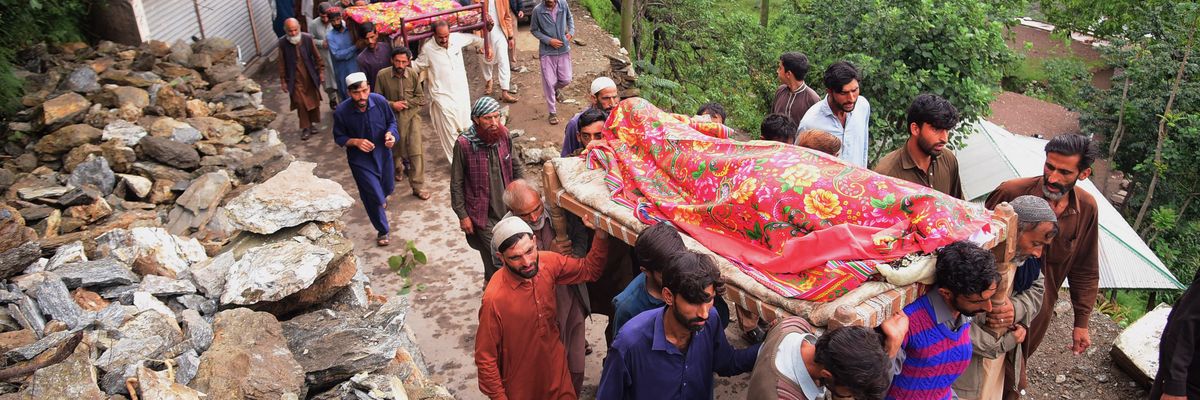

SUBSCRIBE TO OUR FREE NEWSLETTER
Daily news & progressive opinion—funded by the people, not the corporations—delivered straight to your inbox.
5
#000000
#FFFFFF
To donate by check, phone, or other method, see our More Ways to Give page.


Daily news & progressive opinion—funded by the people, not the corporations—delivered straight to your inbox.

Mourners carry the coffins of people who were killed in flash floods in Naryean Behaak village in Pakistan on August 15, 2025.
"The death toll may rise as we are still looking for dozens of missing people," said a spokesperson for an emergency agency in northwestern Pakistan.
Five people on a helicopter rescue team were among nearly 200 people killed by extreme rainfall and flooding in Pakistan in a single day on Friday—the country's latest emergency caused by increasingly severe monsoon seasons, which scientists say are being fueled by the human-caused climate crisis.
The vast majority of deaths were recorded in mountainous areas in the northwestern region, with at least 171 people killed on Friday in Khyber-Pakhtunkhwa.
As the Associated Press reported, "cloudbursts," or sudden and intense downpours over small areas, have become increasingly common in India and northern Pakistan in recent years and have caused landslides and flooding.
Pakistan has faced more extreme heatwaves and abnormal torrential downpours during its monsoon season, which typically occurs from June-September. Glaciers like those in the Gilgit-Balistan region, which hold 75% of Pakistan's stored water supply, have also been melting faster due to higher temperatures—another cause of flash floods. Several landslides have been reported along the Karakoram Highway in that region, which is heavily used by tourists and for trade.
International scientists at the World Weather Attribution said last week that rainfall in Pakistan from June 24-July 23 was 10-15% higher than it would have been without planetary heating linked to fossil fuel emissions, which have steadily risen since the 1950s with wealthy countries including the United States being the biggest contributors.
The death toll from the current ongoing extreme weather, which is expected to continue in the coming days, will likely rise significantly, said officials on Friday.
Authorities suspended an annual Hindu pilgrimage to a Sufi shrine in the northwestern Buner district, which began July 25 and was supposed to continue until early September.
About 78 people have been killed in Buner, mostly by floodwaters that swept them away and houses that collapsed.
Officials were helping nearly 4,000 pilgrims evacuate the area on Friday, building makeshift bridges to help people cross waterways and using dozens of excavators to move boulders, uprooted trees, and other debris.
"The death toll may rise as we are still looking for dozens of missing people," provincial emergency service spokesperson Mohammad Suhail told the AP.
A merchant in the Buner district told the New York Times that he had lost thousands of dollars in goods.
"Everything I had, groceries, edible items, is destroyed," Syed Mehmood Bacah said. "I could not save anything."
The disaster comes three years after Pakistan's worst monsoon season on record, in which flooding killed more than 1,700 people and caused an estimated $40 billion in damages.
Pakistan has become the world's fifth-most vulnerable country to climate disasters despite contributing only about 1% of the world's fossil fuel emissions.
The National Disaster Management Authority said the total number of rain-related deaths has now reached at least 556 since June 26, with more than 700 people injured.
Northern India has also been affected by flash flooding this week, with at least 44 people killed and more than 100 others injured in the Indian-controlled part of Jammu and Kashmir.
Dear Common Dreams reader, The U.S. is on a fast track to authoritarianism like nothing I've ever seen. Meanwhile, corporate news outlets are utterly capitulating to Trump, twisting their coverage to avoid drawing his ire while lining up to stuff cash in his pockets. That's why I believe that Common Dreams is doing the best and most consequential reporting that we've ever done. Our small but mighty team is a progressive reporting powerhouse, covering the news every day that the corporate media never will. Our mission has always been simple: To inform. To inspire. And to ignite change for the common good. Now here's the key piece that I want all our readers to understand: None of this would be possible without your financial support. That's not just some fundraising cliche. It's the absolute and literal truth. We don't accept corporate advertising and never will. We don't have a paywall because we don't think people should be blocked from critical news based on their ability to pay. Everything we do is funded by the donations of readers like you. Will you donate now to help power the nonprofit, independent reporting of Common Dreams? Thank you for being a vital member of our community. Together, we can keep independent journalism alive when it’s needed most. - Craig Brown, Co-founder |
Five people on a helicopter rescue team were among nearly 200 people killed by extreme rainfall and flooding in Pakistan in a single day on Friday—the country's latest emergency caused by increasingly severe monsoon seasons, which scientists say are being fueled by the human-caused climate crisis.
The vast majority of deaths were recorded in mountainous areas in the northwestern region, with at least 171 people killed on Friday in Khyber-Pakhtunkhwa.
As the Associated Press reported, "cloudbursts," or sudden and intense downpours over small areas, have become increasingly common in India and northern Pakistan in recent years and have caused landslides and flooding.
Pakistan has faced more extreme heatwaves and abnormal torrential downpours during its monsoon season, which typically occurs from June-September. Glaciers like those in the Gilgit-Balistan region, which hold 75% of Pakistan's stored water supply, have also been melting faster due to higher temperatures—another cause of flash floods. Several landslides have been reported along the Karakoram Highway in that region, which is heavily used by tourists and for trade.
International scientists at the World Weather Attribution said last week that rainfall in Pakistan from June 24-July 23 was 10-15% higher than it would have been without planetary heating linked to fossil fuel emissions, which have steadily risen since the 1950s with wealthy countries including the United States being the biggest contributors.
The death toll from the current ongoing extreme weather, which is expected to continue in the coming days, will likely rise significantly, said officials on Friday.
Authorities suspended an annual Hindu pilgrimage to a Sufi shrine in the northwestern Buner district, which began July 25 and was supposed to continue until early September.
About 78 people have been killed in Buner, mostly by floodwaters that swept them away and houses that collapsed.
Officials were helping nearly 4,000 pilgrims evacuate the area on Friday, building makeshift bridges to help people cross waterways and using dozens of excavators to move boulders, uprooted trees, and other debris.
"The death toll may rise as we are still looking for dozens of missing people," provincial emergency service spokesperson Mohammad Suhail told the AP.
A merchant in the Buner district told the New York Times that he had lost thousands of dollars in goods.
"Everything I had, groceries, edible items, is destroyed," Syed Mehmood Bacah said. "I could not save anything."
The disaster comes three years after Pakistan's worst monsoon season on record, in which flooding killed more than 1,700 people and caused an estimated $40 billion in damages.
Pakistan has become the world's fifth-most vulnerable country to climate disasters despite contributing only about 1% of the world's fossil fuel emissions.
The National Disaster Management Authority said the total number of rain-related deaths has now reached at least 556 since June 26, with more than 700 people injured.
Northern India has also been affected by flash flooding this week, with at least 44 people killed and more than 100 others injured in the Indian-controlled part of Jammu and Kashmir.
Five people on a helicopter rescue team were among nearly 200 people killed by extreme rainfall and flooding in Pakistan in a single day on Friday—the country's latest emergency caused by increasingly severe monsoon seasons, which scientists say are being fueled by the human-caused climate crisis.
The vast majority of deaths were recorded in mountainous areas in the northwestern region, with at least 171 people killed on Friday in Khyber-Pakhtunkhwa.
As the Associated Press reported, "cloudbursts," or sudden and intense downpours over small areas, have become increasingly common in India and northern Pakistan in recent years and have caused landslides and flooding.
Pakistan has faced more extreme heatwaves and abnormal torrential downpours during its monsoon season, which typically occurs from June-September. Glaciers like those in the Gilgit-Balistan region, which hold 75% of Pakistan's stored water supply, have also been melting faster due to higher temperatures—another cause of flash floods. Several landslides have been reported along the Karakoram Highway in that region, which is heavily used by tourists and for trade.
International scientists at the World Weather Attribution said last week that rainfall in Pakistan from June 24-July 23 was 10-15% higher than it would have been without planetary heating linked to fossil fuel emissions, which have steadily risen since the 1950s with wealthy countries including the United States being the biggest contributors.
The death toll from the current ongoing extreme weather, which is expected to continue in the coming days, will likely rise significantly, said officials on Friday.
Authorities suspended an annual Hindu pilgrimage to a Sufi shrine in the northwestern Buner district, which began July 25 and was supposed to continue until early September.
About 78 people have been killed in Buner, mostly by floodwaters that swept them away and houses that collapsed.
Officials were helping nearly 4,000 pilgrims evacuate the area on Friday, building makeshift bridges to help people cross waterways and using dozens of excavators to move boulders, uprooted trees, and other debris.
"The death toll may rise as we are still looking for dozens of missing people," provincial emergency service spokesperson Mohammad Suhail told the AP.
A merchant in the Buner district told the New York Times that he had lost thousands of dollars in goods.
"Everything I had, groceries, edible items, is destroyed," Syed Mehmood Bacah said. "I could not save anything."
The disaster comes three years after Pakistan's worst monsoon season on record, in which flooding killed more than 1,700 people and caused an estimated $40 billion in damages.
Pakistan has become the world's fifth-most vulnerable country to climate disasters despite contributing only about 1% of the world's fossil fuel emissions.
The National Disaster Management Authority said the total number of rain-related deaths has now reached at least 556 since June 26, with more than 700 people injured.
Northern India has also been affected by flash flooding this week, with at least 44 people killed and more than 100 others injured in the Indian-controlled part of Jammu and Kashmir.